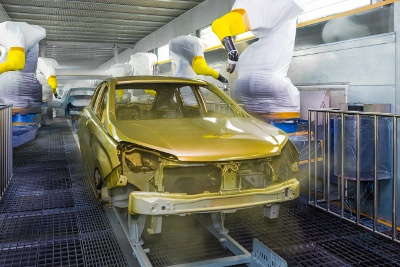Each Sunday, we publish a list of top articles and other content related to manufacturing in areas like quality control, product development, supply chain management, sourcing, auditing and law.
1. What’s holding back more ethical supply chains? Us.
It’s likely that to read this article, you’re viewing it from an electronic device, either a smartphone or computer. But what you might not be actively considering is just how your device came about.
 Your electronic device is likely the result of a complex global supply chain. Raw materials for certain parts of the screen might come from Africa or South America. A processor might come from North America. Assembly is done in Asia. And finally, the product is distributed to consumers in any number of locales.
Your electronic device is likely the result of a complex global supply chain. Raw materials for certain parts of the screen might come from Africa or South America. A processor might come from North America. Assembly is done in Asia. And finally, the product is distributed to consumers in any number of locales.
This widely global sourcing of materials, components and labor can help make products more affordable. Yet in the process, there are sometimes social and environmental complications. To become aware of these problems and address them, some companies implement RFID or blockchain monitoring into their global supply chains.
Technology can only do so much, however. As the author of this featured article points out, in order for technology to be effective, there needs to be a willingness to use it to correct supply chain problems:
There are so many variables that exist... governance, corruption, shrinking of civil space. You can't decouple those trends; they impact the utilization of technology. Technology can never be the solution around the fundamentals of human nature.
Installing the latest Internet of Things (IoT) technology, using the latest gadgets, having amazing supply chain analytics – all these fancy improvements mean nothing if they’re not acted upon. If no one is willing to really take the findings from advanced technologies in supply chains and turn them into actionable steps, then there is still significant room for improvement.
If you’d like to learn more about supply chain transparency, some of the technology aimed at improving it and its limitations, check out the full article in the link below:
Technology Is Failing to Create Transparent Supply Chains – Nithin Coca, Engagdet
2. An anti-bribery ISO standard
Bribery isn’t always obvious. Sometimes, it takes the form of a nice bottle of champagne gifted to a manager. It might be an invitation to an exclusive, ritzy event. Or, in the case of China, it might take a more obvious form, such as a hongbao (a small red envelope filled with money).
Obviously, your staff should resist attempts at bribery. But this is easier said than done. Since bribery thrives in the shadows, it’s hard to prevent it and find out if it’s occurred.
ISO 37001:2016 is an effort to change that. It’s an anti-bribery management system that offers guidance to organizations that want to have greater confidence in their efforts to resist corruption.
Importers and manufacturers can benefit from the standard by guaranteeing to customers that misconduct in their supply chains and organizations is not tolerated. Factory audits, for example, could be taken at face value by a company with this certification because stakeholders will have greater confidence in its auditors to resist factory bribery.
Do you think this ISO standard can actually help reduce corruption and bribery or does it seem far-fetched? Let us know in the comments section below.
To learn more about ISO 37001, check out the full article in the link below:
Putting the Do in Don’t: The New ISO 37001 Standard – DNV GL via Qualitydigest.com
3. Using wearable tech for improved factory safety
I think it almost goes without saying that manufacturing can get a little dangerous. Operating machinery, interacting with chemicals, moving raw materials, you name it – there’s potential for injury and even death in factories.
 There are sometimes alarms or warnings in place to make sure workers don’t hurt themselves. Nowadays, as the industrial Internet of Things appears in more factories, these alerts might be tied to data collected from the factory floor. But as the author of this article points out, there might be too much data to process effectively, leading to too many alerts, which workers then tune out. Instead of data helping workers, it might indirectly make them less concerned about safety.
There are sometimes alarms or warnings in place to make sure workers don’t hurt themselves. Nowadays, as the industrial Internet of Things appears in more factories, these alerts might be tied to data collected from the factory floor. But as the author of this article points out, there might be too much data to process effectively, leading to too many alerts, which workers then tune out. Instead of data helping workers, it might indirectly make them less concerned about safety.
Using wearable technology in combination with data, however, might be the solution to getting factories back on track to safe operations. The author specifies five ways that wearable technology can help manufacturing facilities:
- Enforcement of protocols: wearables can remind workers of correct procedures and practices
- Validation/confirmation of safe operating conditions: employees can learn from their wearables if machinery really is safe to interact with (e.g., that power has been turned off)
- Prevention of strain and fatigue: wearables that can monitor biometrics can send reminders to management and workers about much needed breaks
- Ensuring maintenance compliance: wearable technology can help workers quickly report any malfunctioning equipment
- Emergency response: in an emergency, wearables enable workers to report problems right away and can aid with delivering assistance to those in distress
Curious about how wearables can help improve safety in manufacturing? Check out the full article in the link below:
Fit for Duty: How Wearables Can Protect Workers on the Manufacturing Floor – Don Korfage, Manufacturing.net
4. Saving money on manufacturing electronics
Living in a place like Shenzhen, I’ve come to realize that this is an electronics mecca. Places like Huaqiangbei are like heaven for hardware startups, hobbyists and anyone else that wants to take a crack at making an electronic item.
And even though electronics manufacturing is almost ubiquitous in Shenzhen (and much of the Pearl River Delta), it’s not always cheap. It’s still important to save money.
This featured article offers a few suggestions for saving money when making electronics, including:
- Reduce inter-board wiring complexity
- Use fewer components
- Make the product as easy to assemble as possible
- Try to use common parts
- Use electronics architecture that is integrated with modern chips that allow for multiple functions with a single chip
Are you ready to make your next amazing electronic product more affordable and accessible? If so, check out other ways to save money producing electronics by checking out the article in the link below:
Manufacturing an Electronic Product in China: Ideas for Cost Saving – Renaud Anjoran, Qualityinspection.org
5. Automated painting in production
Painting is sometimes a very tedious task. If you’ve ever done it yourself before, you’ll know that you also have to exercise caution. You don’t want to apply too much paint. You need to be consistent. You don’t want to miss a spot. You don’t want to waste paint. The requirements go on and on.
 At the end of the day, of course, painting isn’t as complex as building a rocket. But it still requires diligence and can eat up time. Thankfully, however, a new technology called the SelfPaint automated painting system can correct those problems.
At the end of the day, of course, painting isn’t as complex as building a rocket. But it still requires diligence and can eat up time. Thankfully, however, a new technology called the SelfPaint automated painting system can correct those problems.
The system uses 20 percent less paint and is 5 percent faster than manual painting. Additionally, it offers the ability to paint small batches of products, and even individual pieces.
While this technology might not seem absolutely revolutionary to some, it can serve a great benefit to importers and manufacturers that use paint in their production processes. Automakers, for example, could employ an automated system like this to improve plant efficiency. If importers are seeing inconsistent paint quality in their orders, they could recommend their factory invest in this solution.
I really wish I could take this system, make it compact and send it back in time to all those instances when I had to paint walls. As much fun as that was, I think using this system would’ve been a bit better.
To learn more about automated painting, check out the full article in the link below:
Automated Painting of Individual Pieces – Fraunhofer-Gesellschaft via Phys.org
We’re constantly scanning the web for top manufacturing stories and news. If you’d like to submit an article for consideration for our weekly Best in Manufacturing, send us a message and let us know.







